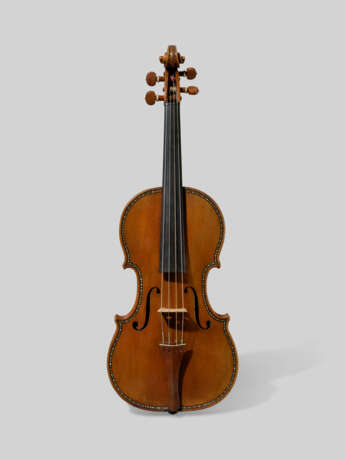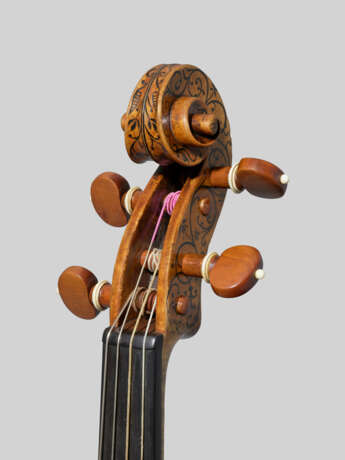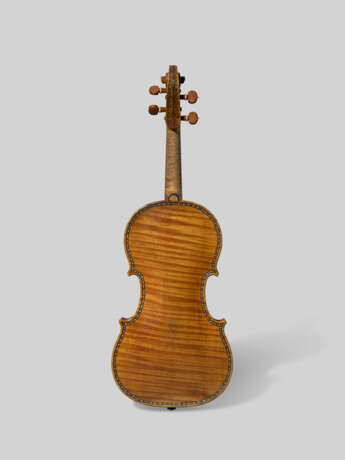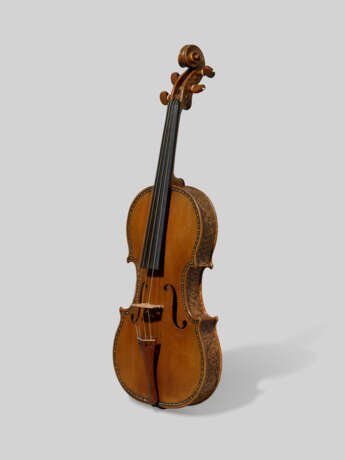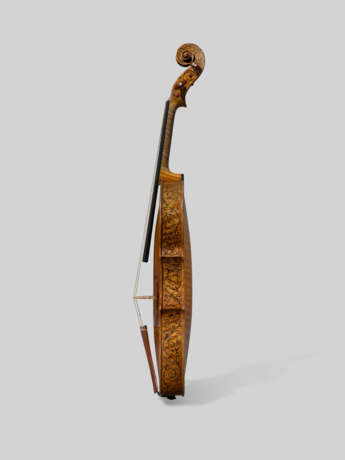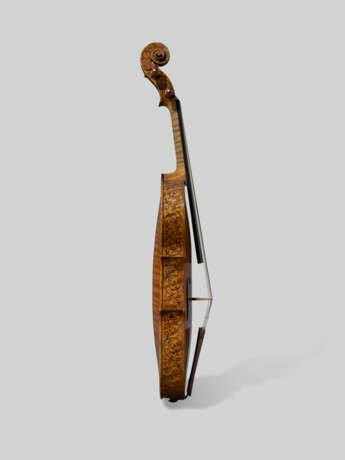ID 791848
Lot 40 | ANTONIO STRADIVARI, THE 'HELLIER' VIOLIN
Valeur estimée
£ 6 000 000 – 9 000 000
CREMONA, 1679
Bearing its original internal label dated 1679; the back in one piece of maple with handsome wide figure descending from left to right; the ribs of similar wood to the back; the scroll of plainer maple; the table in two pieces of spruce with narrow grain, widening at the flanks; the plentifully preserved varnish of a lustrous golden-orange colour over a glowing golden ground. The violin displays original decoration in the form of pearl-shaped ivory inlay around the front and back outline, and intricate ornamentation around the ribs and scroll
Length of back: 14 in. (35.7 cm.)
Upper bouts: 6 11⁄16 in. (17 cm.)
Middle bouts: 4 1⁄2 in. (11.5 cm.)
Lower bouts: 11 7⁄16 in. (29 cm.)
Provenance
John Hellier (1680-1719) of Westminster, bequeathed 'two Cremona violins' to his nephew,
Samuel Hellier (1699-1751), of the Inner Temple and The Wodehouse, Wombourne, Staffordshire, presumably by bequest to his son,
Sir Samuel Hellier Kt. (1736-1784) of The Wodehouse, Wombourne, Staffordshire, by bequest to his friend and executor,
The Reverend Thomas Shaw-Hellier (1732-1812) of The Wodehouse, Wombourne, Staffordshire, by descent to his great-grandson,
Colonel Thomas Bradney Shaw-Hellier (1836-1910) of The Wodehouse, Wombourne, Staffordshire until 2 April 1875 when sold to,
George Crompton, of 54 Barton Arcade, Deansgate, Manchester, sold in 1885 to,
Dr. Charles James Oldham (1845-1907) of Brighton, ophthalmic surgeon and violin collector, until 1890 when sold back to,
Colonel Thomas Bradney Shaw-Hellier (1836-1910) of The Wodehouse, Wombourne, Staffordshire, by descent to his nephew,
Evelyn Simpson, later Shaw-Hellier (1860-1922) of The Wodehouse, Wombourne, Staffordshire, sold December 1911, for £1,600 by,
W. E. Hill & Sons, London, 1910-1911.
With Hamma & Company, Stuttgart, 1912-1925.
Oscar Bondy (1870-1944) of Vienna, entrepreneur and art collector until 1925.
With W. E. Hill & Sons, London, 1925-1932.
Henry Ernest Morriss (1881-1951) of Newmarket and Shanghai, bullion trader, newspaper and racehorse owner, from 1932.
With Rembert Wurlitzer Inc., New York, in 1957.
Henry Hottinger (1885-1979) of New York, banker and renowned collector, until 1965.
With Rembert Wurlitzer Inc., New York, sold in 1979 via,
Alfredo Halegua, The Violin Gallery, Washington D.C., to,
Thomas Morgan Roberts (1937-2012) of Memphis, industrialist, violin and art collector, until 1993 to,
Alfredo Halegua, The Violin Gallery, Washington D.C., sold in 1998 to,
The current owner's family.
Certificates:
Certificate: W. E. Hill & Sons, London, 1957.
Certificate: Rembert Wurlitzer Inc., New York, NY, 1957.
Letter: Rembert Wurlitzer Inc., New York, NY, 1957.
Letter: W. E. Hill & Sons, London, 1957.
Certificate: Machold Rare Violins, Ltd, Vienna, 1998.
Letter: National Museum of American History 1998.
Literature
Will of John Hellier, merchant of St James's, Westminster, Mss. PROB 11⁄569/187, folio 1, 'unto my loving nephew Samuel Hellier son of my Brother Samuel Hellier...my two Cremona violins and the case wherein they now are'.
Sir Samuel Hellier, Manuscript Inventory in Sir Samuel's hand, A Catalogue of Musicall [sic.] Instruments, undated, prior to 1784, folio 1, 'Two Violins in a Mahogony [sic.] Case. Foreign / [one by Nicolas Amatus Cremonem:- 1646. / Antonius Stradiuarius 1679.]'
C. Engel, Catalogue of the Special Exhibition at South Kensington, London, revised edition, 1873, cat. no. 85.
A. J. Hipkins and W. Gibb, Musical Instruments, Historic, Rare and Unique, Edinburgh, 1888, pp. 59-60, ill. pl. xxv.
D. J. Blaikley et al., Musical Instruments and Memorials of Musicians, being the Catalogue of the International Loan Exhibition...Crystal Palace, 1900, cat. no. 124.
W. H. Hill, A. F. Hill, F.S.A., and A. E. Hill, A. Stradivari, His Life and Work (1644-1737), London, 1902, pp. 33, 35, 39, 55.
The Worshipful Company of Musicians, Loan Collection, Fishmongers Hall, London, 1904, cat. p. 154., ill. p. 146.
The Grafton Galleries, Exhibition of Art Treasures, London, 1928, cat. p. 92, ill. p. 112.
CINOA, Exhibition of Art Treasures, Paris, 1954, cat. no. 528, ill. p. 188.
K. Jalovec, Italian Violin Makers, New York, 1958, p. 338.
A. Baruzzi, La Casa Nuziale, London, 1962, pp. 61-68.
Sire Samuel Hellier, The Galpin Society Journal, 'A Catalogue of Musicall Instruments', vol. 18, 1965, pp. 5-6.
W. Hamma, K. Warren, M. Wurlitzer, Loan Exhibition of Stringed Instruments & Bows, New York, 1966, p. 1.
Rembert Wurlitzer Inc,The Henry Hottinger Collection, New York, 1967.
A. Gingrich, A Thousand Mornings of Music, New York, 1970, p. 247.
H. K. Goodkind, Violin Iconography of Stradivari, Larchmont, New York, 1972, pp. 165-166.
W. H. Hill, A. F. Hill, F.S.A. and A. E. Hill, Antonio Stradivari His Life and Work (1644-1737), Fakenham, 1980, pp. 673-675.
S. F. Sacconi, Die ‘Geheminisse’ Stradivaris, Frankfurt/Main, 1981, pp. 141-147.
Gakken Company Ltd., The Classic Bowed Stringed Instruments from the Smithsonian Institution, Tokyo, 1986, ill. pp. 11-19.
C. Beare, Capolavori Di Antonio Stradivari, Cremona, 1987, p. 38-39.
R. Hargrave, The Strad Magazine, 'Antonio Stradivari “Hellier” 1679', September 1987, pp. 676-683, ill. on cover and centerfold.
R. Vannes, Dictionnaire Universel des Luthiers, Spa, 1999, p. 349.
E. N. Doring, enlarged and expanded by R. Bein and G. Fushi, How Many Strads? Our Heritage from the Master, Chicago, Illinois, 1999, pp. 36-37.
C. Frew and A. Myers, The Galpin Society Journal, 'Sir Samuel Hellier's Musicall Instruments', vol. 56, June 2003, pp. 7, 21-23, 25.
Exhibited
London, The South Kensington Museum, Special Exhibition of Ancient Musical Instruments, 1872, cat. no. 85.
London, The Royal Albert Hall, Loan Collection of Historic Musical Instruments, 1885, cat. p. 19.
London, The Crystal Palace, International Music Exhibition, 1900, cat. no. 124.
London, The Fishmongers' Hall, Loan Collection, 1904, cat. p. 154.
London, The Grafton Galleries, Exhibition of Art Treasures, London, 1928, cat. p. 92.
Paris, CINOA, Exhibition of Art Treasures, 1954, cat. no. 528.
New York, Wurlitzer Company, Loan Exhibition of Stringed Instruments and Bows, 1966.
Washington DC, The Smithsonian Institution, Loan Collection, 1979-1987.
Cremona, Palazzo Comunale, Celebrazioni Stradivariane, 1987.
Washington DC, The Smithsonian Institution, Loan Collection, 1998.
Vienna, Kunsthistorisches Museum, Loan Collection, 2003.
Special notice
Prospective purchasers are advised that several countries prohibit the importation of property containing materials from endangered species, including but not limited to coral, ivory and tortoiseshell. Accordingly, prospective purchasers should familiarize themselves with relevant customs regulations prior to bidding if they intend to import this lot into another country.
This lot has been imported from outside of the UK for sale and placed under the Temporary Admission regime. Import VAT is payable at 5% on the hammer price. VAT at 20% will be added to the buyer’s premium but will not be shown separately on our invoice.
Post lot text
Dendrochronological Report
The latest visible ring on the bass side dates from 1670 and the treble side from 1674. Antonio seasoned the wood for circa 4-5 years before using it to make this violin.
This lot contains elephant ivory material and is offered with the benefit of being registered as ‘exempt’ in the UK in accordance with the UK Ivory Act. Please note that it is your responsibility to determine and satisfy the requirements of any applicable regulations relating to the export or import of any lot you purchase. Please also note that from 19 January 2022, Christie’s is unable to ship elephant ivory lots into the EU.
| Catégorie maison de vente aux enchères: | Tous les autres types d'objets |
|---|
| Catégorie maison de vente aux enchères: | Tous les autres types d'objets |
|---|
| Adresse de l'enchère |
CHRISTIE'S 8 King Street, St. James's SW1Y 6QT London Royaume-Uni | |
|---|---|---|
| Aperçu |
| |
| Téléphone | +44 (0)20 7839 9060 | |
| Commission | see on Website | |
| Conditions d'utilisation | Conditions d'utilisation |
